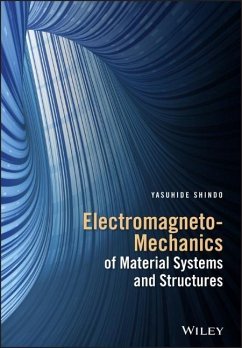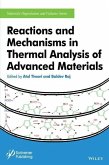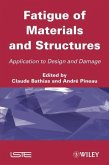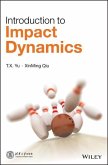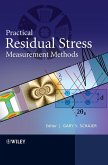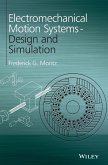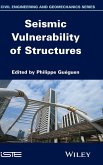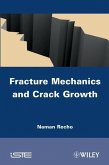Yasuhide Shindo
Electromagneto-Mechanics of Material Systems and Structures
Yasuhide Shindo
Electromagneto-Mechanics of Material Systems and Structures
- Gebundenes Buch
- Merkliste
- Auf die Merkliste
- Bewerten Bewerten
- Teilen
- Produkt teilen
- Produkterinnerung
- Produkterinnerung
Comprehensive introduction to the fundamentals and state of the art research developments in electromagneto-mechanics of adaptive materials
_ Covers a wide and varied range of subject areas (theoretical, experimental, computational studies and/or industrial applications) of electromagneto-mechanics from state-of-the-art fundamental research to applied research, and applications in emerging technologies _ Electromagneto-mechanics of material systems and structures has developed rapidly with extensive applications in electronics industry, nuclear engineering, smart materials and MEMS _ Written by one of the world's leading experts in this field…mehr
Andere Kunden interessierten sich auch für
![Reactions and Mechanisms in Thermal Analysis of Advanced Materials Reactions and Mechanisms in Thermal Analysis of Advanced Materials]() Atul TiwariReactions and Mechanisms in Thermal Analysis of Advanced Materials266,99 €
Atul TiwariReactions and Mechanisms in Thermal Analysis of Advanced Materials266,99 €![Fatigue of Materials and Structures Fatigue of Materials and Structures]() Fatigue of Materials and Structures199,99 €
Fatigue of Materials and Structures199,99 €![Introduction to Impact Dynamics Introduction to Impact Dynamics]() T. X. YuIntroduction to Impact Dynamics146,99 €
T. X. YuIntroduction to Impact Dynamics146,99 €![Residual Stress Residual Stress]() Residual Stress175,99 €
Residual Stress175,99 €![Electromechanical Motion Syste Electromechanical Motion Syste]() Frederick G. MoritzElectromechanical Motion Syste136,99 €
Frederick G. MoritzElectromechanical Motion Syste136,99 €![Seismic Vulnerability of Structures Seismic Vulnerability of Structures]() Philippe GueguenSeismic Vulnerability of Structures190,99 €
Philippe GueguenSeismic Vulnerability of Structures190,99 €![Fracture Mechanics and Crack Growth Fracture Mechanics and Crack Growth]() Naman RechoFracture Mechanics and Crack Growth316,99 €
Naman RechoFracture Mechanics and Crack Growth316,99 €-
-
-
Comprehensive introduction to the fundamentals and state of the art research developments in electromagneto-mechanics of adaptive materials
_ Covers a wide and varied range of subject areas (theoretical, experimental, computational studies and/or industrial applications) of electromagneto-mechanics from state-of-the-art fundamental research to applied research, and applications in emerging technologies
_ Electromagneto-mechanics of material systems and structures has developed rapidly with extensive applications in electronics industry, nuclear engineering, smart materials and MEMS
_ Written by one of the world's leading experts in this field
Hinweis: Dieser Artikel kann nur an eine deutsche Lieferadresse ausgeliefert werden.
_ Covers a wide and varied range of subject areas (theoretical, experimental, computational studies and/or industrial applications) of electromagneto-mechanics from state-of-the-art fundamental research to applied research, and applications in emerging technologies
_ Electromagneto-mechanics of material systems and structures has developed rapidly with extensive applications in electronics industry, nuclear engineering, smart materials and MEMS
_ Written by one of the world's leading experts in this field
Hinweis: Dieser Artikel kann nur an eine deutsche Lieferadresse ausgeliefert werden.
Produktdetails
- Produktdetails
- Verlag: Wiley / Wiley & Sons
- Artikelnr. des Verlages: 1W118837960
- 1. Auflage
- Seitenzahl: 304
- Erscheinungstermin: 7. Juni 2016
- Englisch
- Abmessung: 259mm x 198mm x 36mm
- Gewicht: 1202g
- ISBN-13: 9781118837962
- ISBN-10: 1118837967
- Artikelnr.: 42779159
- Herstellerkennzeichnung
- Libri GmbH
- Europaallee 1
- 36244 Bad Hersfeld
- gpsr@libri.de
- Verlag: Wiley / Wiley & Sons
- Artikelnr. des Verlages: 1W118837960
- 1. Auflage
- Seitenzahl: 304
- Erscheinungstermin: 7. Juni 2016
- Englisch
- Abmessung: 259mm x 198mm x 36mm
- Gewicht: 1202g
- ISBN-13: 9781118837962
- ISBN-10: 1118837967
- Artikelnr.: 42779159
- Herstellerkennzeichnung
- Libri GmbH
- Europaallee 1
- 36244 Bad Hersfeld
- gpsr@libri.de
Yasuhide Shindo, Tohoku University, Japan
About the Author ix
Preface xi
Acknowledgments xiii
1 Introduction 1
References 2
2 Conducting Material Systems and Structures 5
2.1 Basic Equations of Dynamic Magnetoelasticity 5
2.2 Magnetoelastic Plate Vibrations and Waves 7
2.2.1 Classical Plate Bending Theory 9
2.2.2 Mindlin's Theory of Plate Bending 13
2.2.3 Classical Plate Bending Solutions 16
2.2.4 Mindlin Plate Bending Solutions 23
2.2.5 Plane Strain Plate Solutions 26
2.3 Dynamic Magnetoelastic Crack Mechanics 32
2.4 Cracked Materials Under Electromagnetic Force 40
2.5 Summary 45
References 45
3 Dielectric/Ferroelectric Material Systems and Structures 47
Part 3.1 Dielectrics 47
3.1 Basic Equations of Electroelasticity 48
3.2 Static Electroelastic Crack Mechanics 49
3.2.1 Infinite Dielectric Materials 49
3.2.2 Dielectric Strip 57
3.3 Electroelastic Vibrations and Waves 60
3.4 Dynamic Electroelastic Crack Mechanics 68
3.5 Summary 72
Part 3.2 Piezoelectricity 72
3.6 Piezomechanics and Basic Equations 73
3.6.1 Linear Theory 73
3.6.2 Model of Polarization Switching 77
3.6.3 Model of Domain Wall Motion 80
3.6.4 Classical Lamination Theory 82
3.7 Bending of Piezoelectric Laminates 90
3.7.1 Bimorphs 90
3.7.2 Functionally Graded Bimorphs 100
3.7.3 Laminated Plates 111
3.8 Electromechanical Field Concentrations 113
3.8.1 Laminates 113
3.8.2 Disk Composites 123
3.8.3 Fiber Composites 126
3.8.4 MEMS Mirrors 136
3.9 Cryogenic and High-Temperature Electromechanical Responses 140
3.9.1 Cryogenic Electromechanical Response 140
3.9.2 High-Temperature Electromechanical Response 147
3.10 Electric Fracture and Fatigue 149
3.10.1 Fracture Mechanics Parameters 150
3.10.2 Cracked Rectangular Piezoelectric Material 173
3.10.3 Indentation Fracture Test 185
3.10.4 Modified Small Punch Test 189
3.10.5 Single-Edge Precracked Beam Test 193
3.10.6 Double Torsion Test 201
3.10.7 Fatigue of SEPB Specimens 203
3.11 Summary 212
References 213
4 Ferromagnetic Material Systems and Structures 219
Part 4.1 Ferromagnetics 219
4.1 Basic Equations of Magnetoelasticity 220
4.1.1 Soft Ferromagnetic Materials 220
4.1.2 Magnetically Saturated Materials 221
4.1.3 Electromagnetic Materials 222
4.2 Magnetoelastic Instability 224
4.2.1 Buckling of Soft Ferromagnetic Material 225
4.2.2 Buckling of Magnetically Saturated Material 228
4.2.3 Bending of Soft Ferromagnetic Material 231
4.3 Magnetoelastic Vibrations and Waves 233
4.3.1 Vibrations and Waves of Soft Ferromagnetic Material 233
4.3.2 Vibrations and Waves of Magnetically Saturated Material 243
4.4 Magnetic Moment Intensity Factor 250
4.4.1 Simply Supported Plate Under Static Bending 251
4.4.2 Fixed-End Plate Under Static Bending 252
4.4.3 Infinite Plate Under Dynamic Bending 255
4.5 Tensile Fracture and Fatigue 256
4.5.1 Cracked Rectangular Soft Ferromagnetic Material 257
4.5.2 Fracture Test 261
4.5.3 Fatigue Crack Growth Test 263
4.6 Summary 265
Part 4.2 Magnetostriction 265
4.7 Basic Equations of Magnetostriction 265
4.8 Nonlinear Magneto-Mechanical Response 267
Preface xi
Acknowledgments xiii
1 Introduction 1
References 2
2 Conducting Material Systems and Structures 5
2.1 Basic Equations of Dynamic Magnetoelasticity 5
2.2 Magnetoelastic Plate Vibrations and Waves 7
2.2.1 Classical Plate Bending Theory 9
2.2.2 Mindlin's Theory of Plate Bending 13
2.2.3 Classical Plate Bending Solutions 16
2.2.4 Mindlin Plate Bending Solutions 23
2.2.5 Plane Strain Plate Solutions 26
2.3 Dynamic Magnetoelastic Crack Mechanics 32
2.4 Cracked Materials Under Electromagnetic Force 40
2.5 Summary 45
References 45
3 Dielectric/Ferroelectric Material Systems and Structures 47
Part 3.1 Dielectrics 47
3.1 Basic Equations of Electroelasticity 48
3.2 Static Electroelastic Crack Mechanics 49
3.2.1 Infinite Dielectric Materials 49
3.2.2 Dielectric Strip 57
3.3 Electroelastic Vibrations and Waves 60
3.4 Dynamic Electroelastic Crack Mechanics 68
3.5 Summary 72
Part 3.2 Piezoelectricity 72
3.6 Piezomechanics and Basic Equations 73
3.6.1 Linear Theory 73
3.6.2 Model of Polarization Switching 77
3.6.3 Model of Domain Wall Motion 80
3.6.4 Classical Lamination Theory 82
3.7 Bending of Piezoelectric Laminates 90
3.7.1 Bimorphs 90
3.7.2 Functionally Graded Bimorphs 100
3.7.3 Laminated Plates 111
3.8 Electromechanical Field Concentrations 113
3.8.1 Laminates 113
3.8.2 Disk Composites 123
3.8.3 Fiber Composites 126
3.8.4 MEMS Mirrors 136
3.9 Cryogenic and High-Temperature Electromechanical Responses 140
3.9.1 Cryogenic Electromechanical Response 140
3.9.2 High-Temperature Electromechanical Response 147
3.10 Electric Fracture and Fatigue 149
3.10.1 Fracture Mechanics Parameters 150
3.10.2 Cracked Rectangular Piezoelectric Material 173
3.10.3 Indentation Fracture Test 185
3.10.4 Modified Small Punch Test 189
3.10.5 Single-Edge Precracked Beam Test 193
3.10.6 Double Torsion Test 201
3.10.7 Fatigue of SEPB Specimens 203
3.11 Summary 212
References 213
4 Ferromagnetic Material Systems and Structures 219
Part 4.1 Ferromagnetics 219
4.1 Basic Equations of Magnetoelasticity 220
4.1.1 Soft Ferromagnetic Materials 220
4.1.2 Magnetically Saturated Materials 221
4.1.3 Electromagnetic Materials 222
4.2 Magnetoelastic Instability 224
4.2.1 Buckling of Soft Ferromagnetic Material 225
4.2.2 Buckling of Magnetically Saturated Material 228
4.2.3 Bending of Soft Ferromagnetic Material 231
4.3 Magnetoelastic Vibrations and Waves 233
4.3.1 Vibrations and Waves of Soft Ferromagnetic Material 233
4.3.2 Vibrations and Waves of Magnetically Saturated Material 243
4.4 Magnetic Moment Intensity Factor 250
4.4.1 Simply Supported Plate Under Static Bending 251
4.4.2 Fixed-End Plate Under Static Bending 252
4.4.3 Infinite Plate Under Dynamic Bending 255
4.5 Tensile Fracture and Fatigue 256
4.5.1 Cracked Rectangular Soft Ferromagnetic Material 257
4.5.2 Fracture Test 261
4.5.3 Fatigue Crack Growth Test 263
4.6 Summary 265
Part 4.2 Magnetostriction 265
4.7 Basic Equations of Magnetostriction 265
4.8 Nonlinear Magneto-Mechanical Response 267
About the Author ix
Preface xi
Acknowledgments xiii
1 Introduction 1
References 2
2 Conducting Material Systems and Structures 5
2.1 Basic Equations of Dynamic Magnetoelasticity 5
2.2 Magnetoelastic Plate Vibrations and Waves 7
2.2.1 Classical Plate Bending Theory 9
2.2.2 Mindlin's Theory of Plate Bending 13
2.2.3 Classical Plate Bending Solutions 16
2.2.4 Mindlin Plate Bending Solutions 23
2.2.5 Plane Strain Plate Solutions 26
2.3 Dynamic Magnetoelastic Crack Mechanics 32
2.4 Cracked Materials Under Electromagnetic Force 40
2.5 Summary 45
References 45
3 Dielectric/Ferroelectric Material Systems and Structures 47
Part 3.1 Dielectrics 47
3.1 Basic Equations of Electroelasticity 48
3.2 Static Electroelastic Crack Mechanics 49
3.2.1 Infinite Dielectric Materials 49
3.2.2 Dielectric Strip 57
3.3 Electroelastic Vibrations and Waves 60
3.4 Dynamic Electroelastic Crack Mechanics 68
3.5 Summary 72
Part 3.2 Piezoelectricity 72
3.6 Piezomechanics and Basic Equations 73
3.6.1 Linear Theory 73
3.6.2 Model of Polarization Switching 77
3.6.3 Model of Domain Wall Motion 80
3.6.4 Classical Lamination Theory 82
3.7 Bending of Piezoelectric Laminates 90
3.7.1 Bimorphs 90
3.7.2 Functionally Graded Bimorphs 100
3.7.3 Laminated Plates 111
3.8 Electromechanical Field Concentrations 113
3.8.1 Laminates 113
3.8.2 Disk Composites 123
3.8.3 Fiber Composites 126
3.8.4 MEMS Mirrors 136
3.9 Cryogenic and High-Temperature Electromechanical Responses 140
3.9.1 Cryogenic Electromechanical Response 140
3.9.2 High-Temperature Electromechanical Response 147
3.10 Electric Fracture and Fatigue 149
3.10.1 Fracture Mechanics Parameters 150
3.10.2 Cracked Rectangular Piezoelectric Material 173
3.10.3 Indentation Fracture Test 185
3.10.4 Modified Small Punch Test 189
3.10.5 Single-Edge Precracked Beam Test 193
3.10.6 Double Torsion Test 201
3.10.7 Fatigue of SEPB Specimens 203
3.11 Summary 212
References 213
4 Ferromagnetic Material Systems and Structures 219
Part 4.1 Ferromagnetics 219
4.1 Basic Equations of Magnetoelasticity 220
4.1.1 Soft Ferromagnetic Materials 220
4.1.2 Magnetically Saturated Materials 221
4.1.3 Electromagnetic Materials 222
4.2 Magnetoelastic Instability 224
4.2.1 Buckling of Soft Ferromagnetic Material 225
4.2.2 Buckling of Magnetically Saturated Material 228
4.2.3 Bending of Soft Ferromagnetic Material 231
4.3 Magnetoelastic Vibrations and Waves 233
4.3.1 Vibrations and Waves of Soft Ferromagnetic Material 233
4.3.2 Vibrations and Waves of Magnetically Saturated Material 243
4.4 Magnetic Moment Intensity Factor 250
4.4.1 Simply Supported Plate Under Static Bending 251
4.4.2 Fixed-End Plate Under Static Bending 252
4.4.3 Infinite Plate Under Dynamic Bending 255
4.5 Tensile Fracture and Fatigue 256
4.5.1 Cracked Rectangular Soft Ferromagnetic Material 257
4.5.2 Fracture Test 261
4.5.3 Fatigue Crack Growth Test 263
4.6 Summary 265
Part 4.2 Magnetostriction 265
4.7 Basic Equations of Magnetostriction 265
4.8 Nonlinear Magneto-Mechanical Response 267
Preface xi
Acknowledgments xiii
1 Introduction 1
References 2
2 Conducting Material Systems and Structures 5
2.1 Basic Equations of Dynamic Magnetoelasticity 5
2.2 Magnetoelastic Plate Vibrations and Waves 7
2.2.1 Classical Plate Bending Theory 9
2.2.2 Mindlin's Theory of Plate Bending 13
2.2.3 Classical Plate Bending Solutions 16
2.2.4 Mindlin Plate Bending Solutions 23
2.2.5 Plane Strain Plate Solutions 26
2.3 Dynamic Magnetoelastic Crack Mechanics 32
2.4 Cracked Materials Under Electromagnetic Force 40
2.5 Summary 45
References 45
3 Dielectric/Ferroelectric Material Systems and Structures 47
Part 3.1 Dielectrics 47
3.1 Basic Equations of Electroelasticity 48
3.2 Static Electroelastic Crack Mechanics 49
3.2.1 Infinite Dielectric Materials 49
3.2.2 Dielectric Strip 57
3.3 Electroelastic Vibrations and Waves 60
3.4 Dynamic Electroelastic Crack Mechanics 68
3.5 Summary 72
Part 3.2 Piezoelectricity 72
3.6 Piezomechanics and Basic Equations 73
3.6.1 Linear Theory 73
3.6.2 Model of Polarization Switching 77
3.6.3 Model of Domain Wall Motion 80
3.6.4 Classical Lamination Theory 82
3.7 Bending of Piezoelectric Laminates 90
3.7.1 Bimorphs 90
3.7.2 Functionally Graded Bimorphs 100
3.7.3 Laminated Plates 111
3.8 Electromechanical Field Concentrations 113
3.8.1 Laminates 113
3.8.2 Disk Composites 123
3.8.3 Fiber Composites 126
3.8.4 MEMS Mirrors 136
3.9 Cryogenic and High-Temperature Electromechanical Responses 140
3.9.1 Cryogenic Electromechanical Response 140
3.9.2 High-Temperature Electromechanical Response 147
3.10 Electric Fracture and Fatigue 149
3.10.1 Fracture Mechanics Parameters 150
3.10.2 Cracked Rectangular Piezoelectric Material 173
3.10.3 Indentation Fracture Test 185
3.10.4 Modified Small Punch Test 189
3.10.5 Single-Edge Precracked Beam Test 193
3.10.6 Double Torsion Test 201
3.10.7 Fatigue of SEPB Specimens 203
3.11 Summary 212
References 213
4 Ferromagnetic Material Systems and Structures 219
Part 4.1 Ferromagnetics 219
4.1 Basic Equations of Magnetoelasticity 220
4.1.1 Soft Ferromagnetic Materials 220
4.1.2 Magnetically Saturated Materials 221
4.1.3 Electromagnetic Materials 222
4.2 Magnetoelastic Instability 224
4.2.1 Buckling of Soft Ferromagnetic Material 225
4.2.2 Buckling of Magnetically Saturated Material 228
4.2.3 Bending of Soft Ferromagnetic Material 231
4.3 Magnetoelastic Vibrations and Waves 233
4.3.1 Vibrations and Waves of Soft Ferromagnetic Material 233
4.3.2 Vibrations and Waves of Magnetically Saturated Material 243
4.4 Magnetic Moment Intensity Factor 250
4.4.1 Simply Supported Plate Under Static Bending 251
4.4.2 Fixed-End Plate Under Static Bending 252
4.4.3 Infinite Plate Under Dynamic Bending 255
4.5 Tensile Fracture and Fatigue 256
4.5.1 Cracked Rectangular Soft Ferromagnetic Material 257
4.5.2 Fracture Test 261
4.5.3 Fatigue Crack Growth Test 263
4.6 Summary 265
Part 4.2 Magnetostriction 265
4.7 Basic Equations of Magnetostriction 265
4.8 Nonlinear Magneto-Mechanical Response 267

